oil Alfa Romeo GT 2010 Owner handbook (in English)
[x] Cancel search | Manufacturer: ALFA ROMEO, Model Year: 2010, Model line: GT, Model: Alfa Romeo GT 2010Pages: 271, PDF Size: 5.34 MB
Page 105 of 271
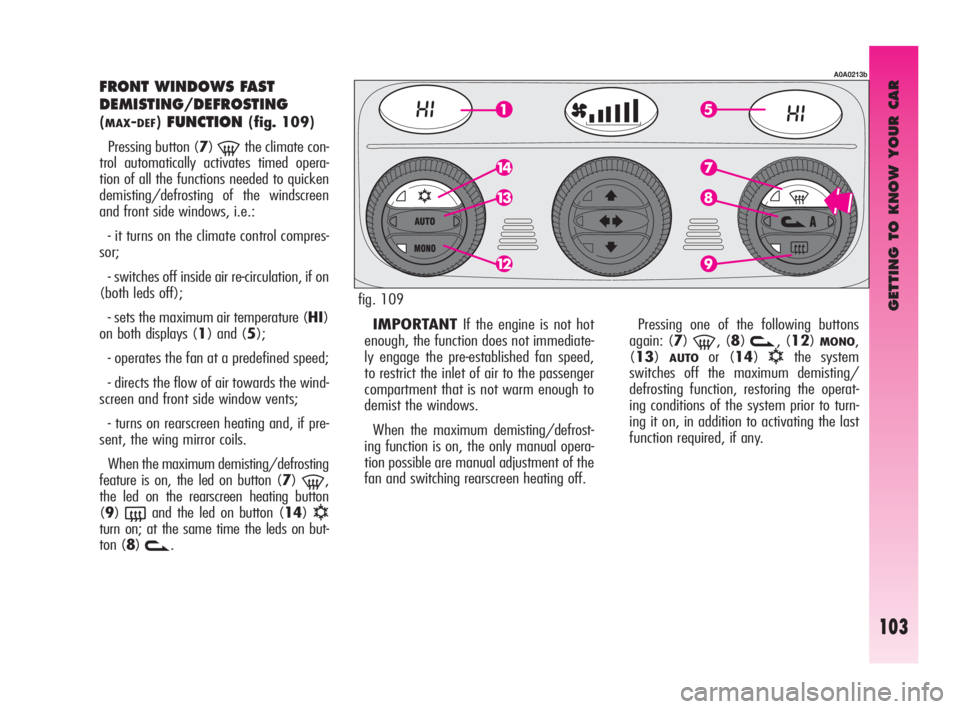
GETTING TO KNOW YOUR CAR
103
FRONT WINDOWS FAST
DEMISTING/DEFROSTING
(MAX-DEF)FUNCTION(fig. 109)
Pressing button (7)
-the climate con-
trol automatically activates timed opera-
tion of all the functions needed to quicken
demisting/defrosting of the windscreen
and front side windows, i.e.:
- it turns on the climate control compres-
sor;
- switches off inside air re-circulation, if on
(both leds off);
- sets the maximum air temperature (HI)
on both displays (1) and (5);
- operates the fan at a predefined speed;
- directs the flow of air towards the wind-
screen and front side window vents;
- turns on rearscreen heating and, if pre-
sent, the wing mirror coils.
When the maximum demisting/defrosting
feature is on, the led on button (7)
-,
the led on the rearscreen heating button
(9)
(and the led on button (14)√turn on; at the same time the leds on but-
ton (8)
v.IMPORTANTIf the engine is not hot
enough, the function does not immediate-
ly engage the pre-established fan speed,
to restrict the inlet of air to the passenger
compartment that is not warm enough to
demist the windows.
When the maximum demisting/defrost-
ing function is on, the only manual opera-
tion possible are manual adjustment of the
fan and switching rearscreen heating off. Pressing one of the following buttons
again: (7)
-, (8)v, (12)MONO,
(13)
AUTOor (14)√the system
switches off the maximum demisting/
defrosting function, restoring the operat-
ing conditions of the system prior to turn-
ing it on, in addition to activating the last
function required, if any.
A0A0213b
fig. 109
Page 106 of 271

GETTING TO KNOW YOUR CAR
104
WING MIRROR AND
REARSCREEN
DEFROSTING/DEMISTING
BUTTON
(fig. 110)
Pressing button (9)
(turns on
demisting/defrosting of the rearscreen
and, if present, the wing mirror coils.
The turning on of this function is shown
by the turning on of the led on the button.
This function is timed and switches off
automatically after 20 minutes, or press-
ing the button again; the function is also
switched off when the engine is stopped
and will not be switched on again the next
time the engine is started.
IMPORTANTThe system automatical-
ly turns on rearscreen heating if the tem-
perature is below 3°C.
IMPORTANTDo not apply stickers on
the inside of the rearscreen over the heat-
ing filaments to avoid damage that might
cause it to stop working properly.
POLLEN FILTER
Have the conditions of the filter checked
by Alfa Romeo Authorised Services at least
once a year, preferably at the onset of
summer.
If the car is used mainly in dusty or pol-
luted areas it should be checked and, if
necessary, replaced at shorter intervals.
A0A0214b
The filter has the specific capability of fil-
tering external air, thus admitting to the
passenger compartment purified air, free
from particles such as dust, pollen, etc.
In addition to the above mentioned func-
tions, is also reduces the concentration of
pollutants.
The filtering action takes place under all
air inlet conditions and it is clearly most
effective with the windows shut.If the filter is not replaced
the efficiency of the cli-
mate control system may
be seriously compromised up to
blocking the air flow at the outlets
and vents.
fig. 110
Page 130 of 271

GETTING TO KNOW YOUR CAR
128
OPENING FROM INSIDE
(fig. 141)
Tailgate is released electrically and this can
be performed only when the ignition key
is in position MARwith car at a standstill
or in STOPorPARKposition for 3 min-
utes without unlocking/locking one of the
doors.
To unlock the tailgate, press button (A)
on the centre console panel.
Tailgate raising is facilitated by the gas
shock springs.
OPENING WITH REMOTE
CONTROL
(fig. 142)
The tailgate can be opened by remote con-
trol from outside pressing the button (A),
also when the electronic alarm is engaged.
Opening of the tailgate is accompanied by
a double flash of the direction indicators;
closing is accompanied by a single flash.
If an electronic alarm is fitted, with the
opening of the tailgate, the alarm system
switches off volumetric protection and the
tailgate control sensor, the system “beeps”
twice (with the exception of certain mar-
kets).
fig. 141
A0A0129b
BOOT
The tailgate can be opened:
from the outside of the car- by a
remote control impulse;
from the inside of the door- by de-
pressing the button (A-fig. 141).
IMPORTANTIf the boot is not proper-
ly shut, the
´warning light will come on
(on certain versions accompanied by the
message on the reconfigurable multifunction
display).
The gas springs are cali-
brated to ensure correct
tailgate raising with the
weights foreseen by the manufac-
turer. The arbitrary addition of
items (such spoilers, etc.) may
compromise the correct operation
and safety of the actual tailgate.
fig. 142
A0A0636b
Page 138 of 271

GETTING TO KNOW YOUR CAR
136
VDC SYSTEM
(Vehicle Dynamics Control)
(on request for versions/
markets where applicable)
The VDC is an electronic system that con-
trols car stability, intervening on the driving
torque and braking the wheels in a differ-
entiated manner, in the lack of grip, it helps
to bring the car back to the correct direction.
When travelling the car is subjected to lat-
eral and longitudinal forces which can be
controlled by the driver as long as the tyres
offer adequate roadholding; when this falls
below the minimum level, the car begins
to divert from the course required by the dri-
ver.
Especially when travelling on an uneven
surface (such as paving, or due to the pres-
ence of water, ice or soil), changes in speed
(acceleration or braking) and/or course
(bends or the need to avoid obstacles) may
cause the tyres to lose grip. When the sensors detect the conditions
that would lead to skidding, the system in-
tervenes on the engine and on the brakes
producing a stabilising torque.
HOW THE VDC
SYSTEM WORKS
System is engaged automatically when the
car is started and cannot be switched off.
The basic components of the system are:
– an electronic control unit that process-
es the signals received from the various sen-
sors and brings about the most appropriate
strategy;
– a sensor that detects the position of the
steering wheels;
– four sensors that detect the turning
speed of each wheel;
– a sensor that detects rotation of the car
around its vertical axis;
– a sensor that detects lateral acceleration
(centrifugal force).
The heart of the system is the control unit,
which with the data supplied by the sensors
installed on the car calculates the centrifugal
forces generated when the car is cornering.
The yawing sensor, which originates from the
aeronautical industry, detects the rotations
of the car around its own vertical axis. The
centrifugal forces generated when the car
is cornering are detected by a highly sensi-
tive lateral acceleration sensor. The performance of the
system, in terms of active
safety should not induce
the driver to take pointless and un-
necessary risks. The style of dri-
ving must in any case always be
adapted to the conditions of the
road surface, visibility and traffic.
The responsibility for road safety
is always and in any case the dri-
ver’s.
System helps the driver to keep the car un-
der control in the event of a loss of tyre grip.
The forces induced by the system to con-
trol the loss of car stability always depend
on the grip between the tyre and the road
surface.
Page 144 of 271
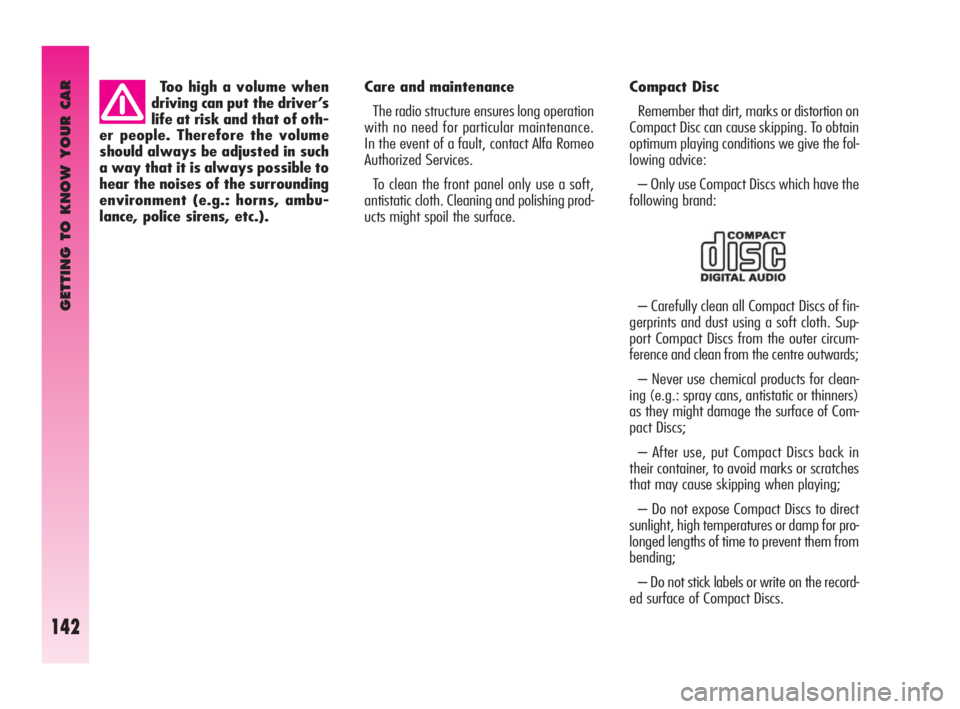
GETTING TO KNOW YOUR CAR
142
Care and maintenance
The radio structure ensures long operation
with no need for particular maintenance.
In the event of a fault, contact Alfa Romeo
Authorized Services.
To clean the front panel only use a soft,
antistatic cloth. Cleaning and polishing prod-
ucts might spoil the surface. Compact Disc
Remember that dirt, marks or distortion on
Compact Disc can cause skipping. To obtain
optimum playing conditions we give the fol-
lowing advice:
– Only use Compact Discs which have the
following brand:
– Carefully clean all Compact Discs of fin-
gerprints and dust using a soft cloth. Sup-
port Compact Discs from the outer circum-
ference and clean from the centre outwards;
– Never use chemical products for clean-
ing (e.g.: spray cans, antistatic or thinners)
as they might damage the surface of Com-
pact Discs;
– After use, put Compact Discs back in
their container, to avoid marks or scratches
that may cause skipping when playing;
– Do not expose Compact Discs to direct
sunlight, high temperatures or damp for pro-
longed lengths of time to prevent them from
bending;
– Do not stick labels or write on the record-
ed surface of Compact Discs. Too high a volume when
driving can put the driver’s
life at risk and that of oth-
er people. Therefore the volume
should always be adjusted in such
a way that it is always possible to
hear the noises of the surrounding
environment (e.g.: horns, ambu-
lance, police sirens, etc.).
Page 210 of 271
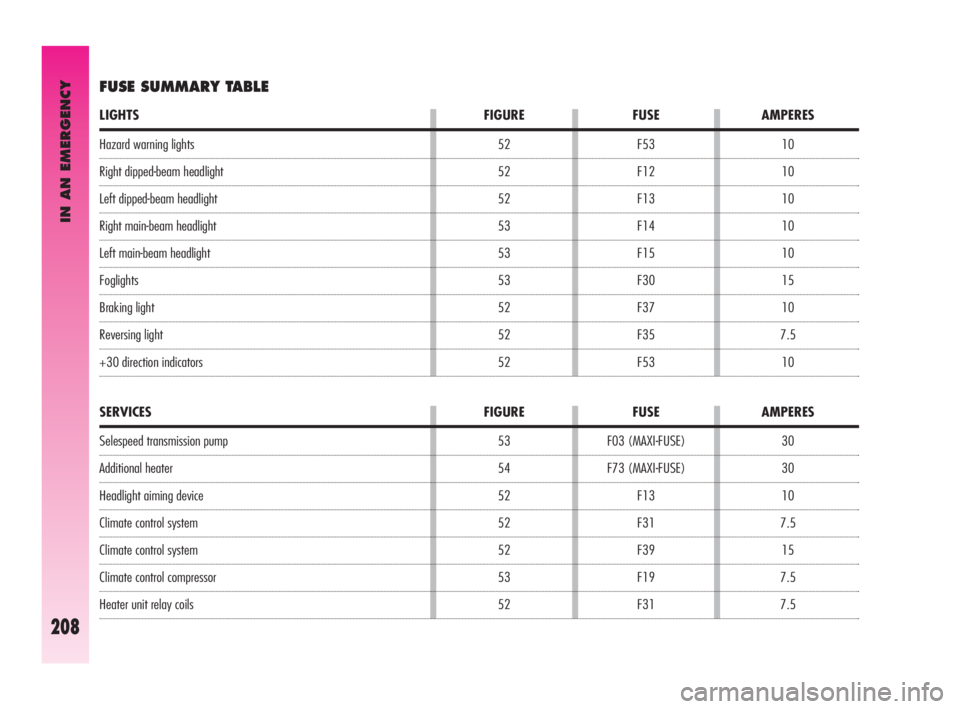
IN AN EMERGENCY
208
30
30
10
7.5
15
7.5
7.5 F03 (MAXI-FUSE)
F73 (MAXI-FUSE)
F13
F31
F39
F19
F31
SERVICES FIGURE FUSE AMPERES
Hazard warning lights
Right dipped-beam headlight
Left dipped-beam headlight
Right main-beam headlight
Left main-beam headlight
Foglights
Braking light
Reversing light
+30 direction indicators10
10
10
10
10
15
10
7.5
10 F53
F12
F13
F14
F15
F30
F37
F35
F53
LIGHTS FIGURE FUSE AMPERES
FUSE SUMMARY TABLE
Selespeed transmission pump
Additional heater
Headlight aiming device
Climate control system
Climate control system
Climate control compressor
Heater unit relay coils52
52
52
53
53
53
52
52
52
53
54
52
52
52
53
52
Page 213 of 271

IN AN EMERGENCY
211
40
30
50
15
15
15
15
25
7.5
15
15
30
30
50
20
150
40
60
20 F05 (MAXI-FUSE)
F06 (MAXI-FUSE)
F07 (MAXI-FUSE)
F10
F21
F22
F21
F60 (*)
F16
F61 (*)
F62 (*)
F08
F72 (MAXI-FUSE)
F01 (MAXI-FUSE)
F20
F70 (MEGA-FUSE)
F06 (MAXI-FUSE)
F07 (MAXI-FUSE)
F22 53
53
53
53
53
53
53
52
53
52
52
53
54
53
53
54
53
53
53
SERVICES FIGURE FUSE AMPERES
(*) Fuse behind dashboard control box on an auxiliary bracket.
Climate control fan
Radiator fan (first speed - petrol versions)
Radiator fan (second speed - petrol versions)
Horn
Fuel pump
Injectors (petrol versions)
Ignition coils
Tailgate electric unlocking
Electronic injection system
Bose system
Bose system
Additional heater
Ignition switch
Glow plug warming (JTD versions)
Heated fuel oil filter (JTD versions)
Engine compartment control box (JTD versions)
Radiator fan (first speed – JTD versions)
Radiator fan (second speed – JTD versions)
Injectors (JTD versions)
Page 220 of 271

●●●●●●●●●
●●
●●●●
●●●●
●●
●
●●●
●
●
●
●●●●●●●●●
●●●●●●●●●
●●●
●●●●●●●●●
●●●●●●●●●
CAR MAINTENANCE
218
20 40 60 80 100 120 140 160 180Thousands of km
Check and if necessary top up the Selespeed automatic transmission oil level
(2.0 JTS versions)
Sight check for conditions of timing gear drive toothed belt (3.2 V6 and JTD versions)
Check emissions/smoke at the exhaust (JTD versions)
Check operation of engine control system (through diagnosis socket)
Check mechanical transmission oil level
Change counter-rotating shaft drive belt
Change timing gear drive belt (1.8 T.SPARK and 2.0 JTS versions) (*)
Change timing gear drive belt (3.2 V6 and JTD versions) (*)
Change accessory poly-V drive belt
Change spark plugs (petrol versions)
Change engine oil and oil filter (petrol versions) (or every 24 months)
Change engine oil and oil filter (diesel with DPF versions)(**)
(or every 24 months)
Change engine oil and oil filter (diesel without DPF versions)(**)
(or every 24 months)
Change brake fluid (or every 24 months)
Change fuel filter (JTD versions)
Change pollen filter (or every year)
(*) Regardless of the km covered, the timing belt shall be replaced every 4 years for particularly demanding use (cold climates, driving in the city, idling for a long time) or in any case every 5 years.
(**) Engine oil and oil filter shall actually be changed according to the conditions of use of the car and it is indicated by the relevant warning light or message (where provided) on the instrument panel
(see “Warning lights and messages” paragraph).
If the car is used mainly on urban routes or if the yearly kilometres travelled are less than 10,000 km, the engine oil and filter must be changed every 12 months.
Page 221 of 271
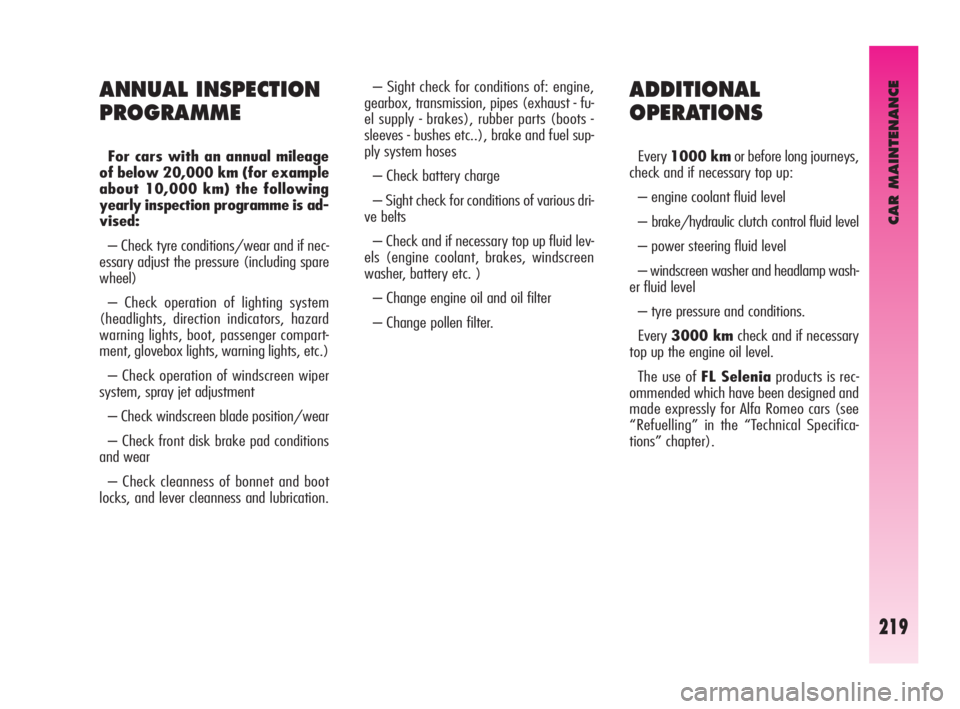
CAR MAINTENANCE
219
ADDITIONAL
OPERATIONS
Every 1000 kmor before long journeys,
check and if necessary top up:
– engine coolant fluid level
– brake/hydraulic clutch control fluid level
– power steering fluid level
– windscreen washer and headlamp wash-
er fluid level
– tyre pressure and conditions.
Every 3000 kmcheck and if necessary
top up the engine oil level.
The use of FL Seleniaproducts is rec-
ommended which have been designed and
made expressly for Alfa Romeo cars (see
“Refuelling” in the “Technical Specifica-
tions” chapter).
ANNUAL INSPECTION
PROGRAMME
For cars with an annual mileage
of below 20,000 km (for example
about 10,000 km) the following
yearly inspection programme is ad-
vised:
– Check tyre conditions/wear and if nec-
essary adjust the pressure (including spare
wheel)
– Check operation of lighting system
(headlights, direction indicators, hazard
warning lights, boot, passenger compart-
ment, glovebox lights, warning lights, etc.)
– Check operation of windscreen wiper
system, spray jet adjustment
– Check windscreen blade position/wear
– Check front disk brake pad conditions
and wear
– Check cleanness of bonnet and boot
locks, and lever cleanness and lubrication.– Sight check for conditions of: engine,
gearbox, transmission, pipes (exhaust - fu-
el supply - brakes), rubber parts (boots -
sleeves - bushes etc..), brake and fuel sup-
ply system hoses
– Check battery charge
– Sight check for conditions of various dri-
ve belts
– Check and if necessary top up fluid lev-
els (engine coolant, brakes, windscreen
washer, battery etc. )
– Change engine oil and oil filter
– Change pollen filter.
Page 222 of 271
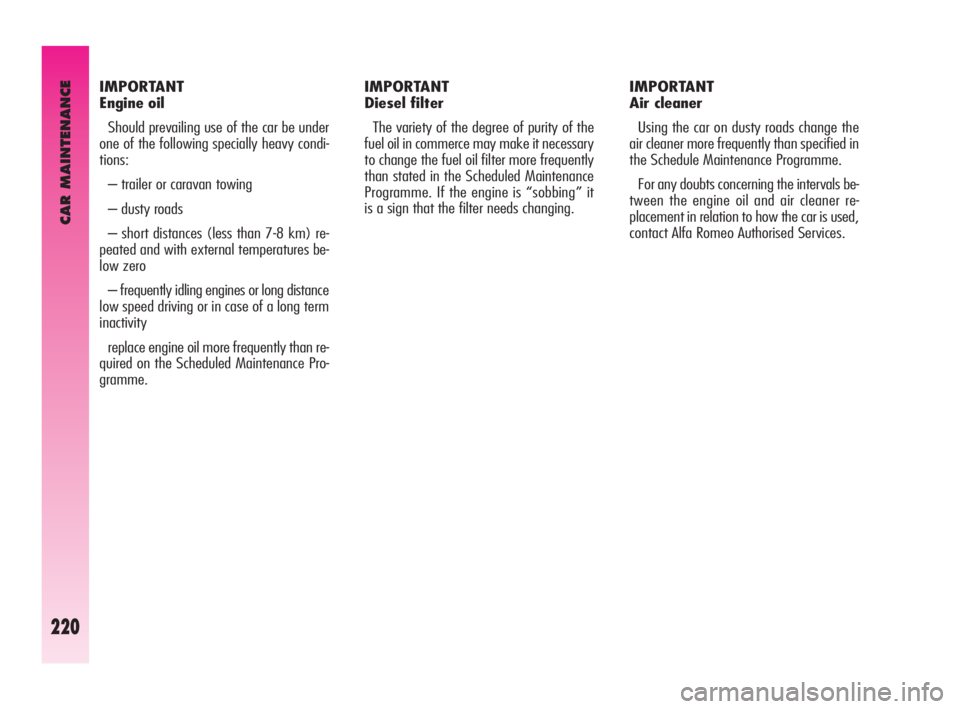
CAR MAINTENANCE
220
IMPORTANT
Engine oil
Should prevailing use of the car be under
one of the following specially heavy condi-
tions:
– trailer or caravan towing
– dusty roads
– short distances (less than 7-8 km) re-
peated and with external temperatures be-
low zero
– frequently idling engines or long distance
low speed driving or in case of a long term
inactivity
replace engine oil more frequently than re-
quired on the Scheduled Maintenance Pro-
gramme.IMPORTANT
Diesel filter
The variety of the degree of purity of the
fuel oil in commerce may make it necessary
to change the fuel oil filter more frequently
than stated in the Scheduled Maintenance
Programme. If the engine is “sobbing” it
is a sign that the filter needs changing.IMPORTANT
Air cleaner
Using the car on dusty roads change the
air cleaner more frequently than specified in
the Schedule Maintenance Programme.
For any doubts concerning the intervals be-
tween the engine oil and air cleaner re-
placement in relation to how the car is used,
contact Alfa Romeo Authorised Services.